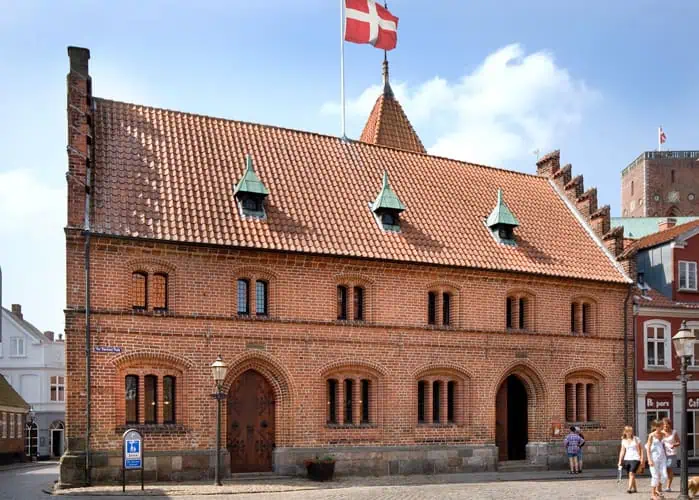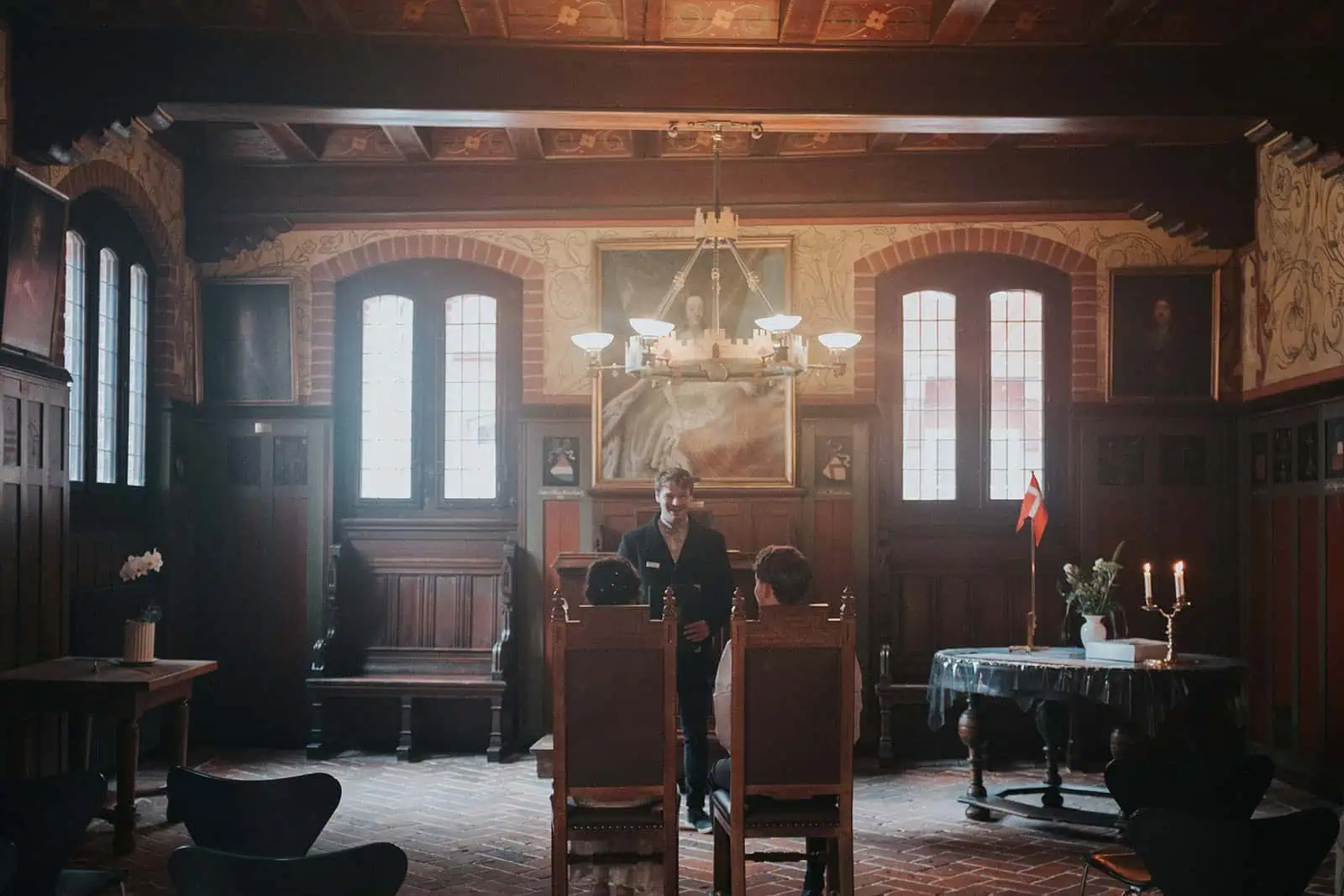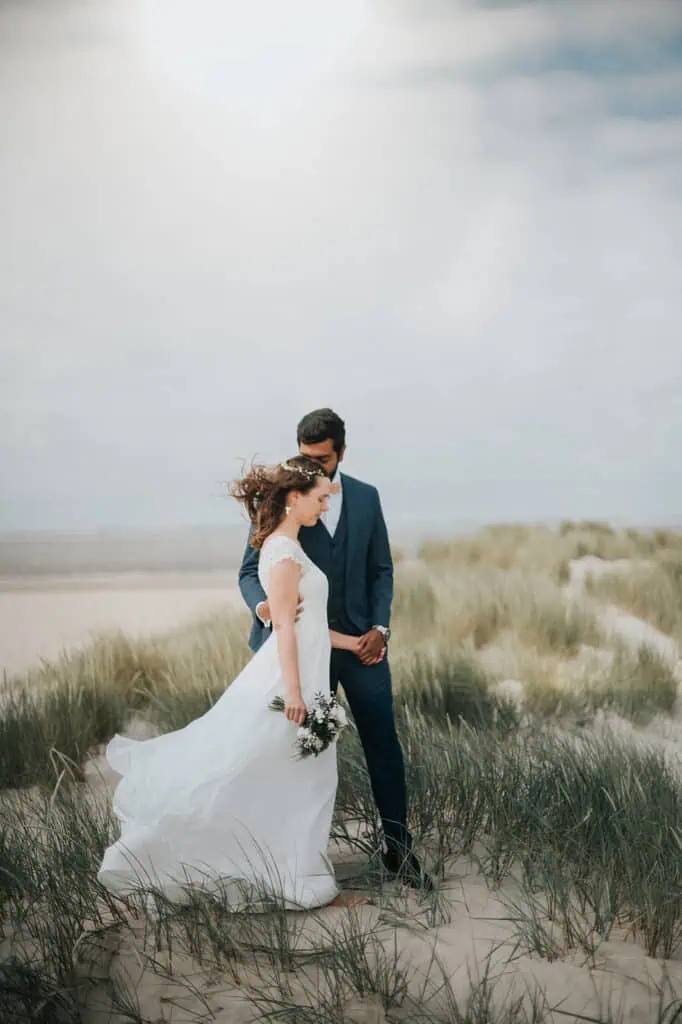Listen to this article
Getting married in Ribe is the perfect choice for couples who want to experience a wedding in Denmark close to the German border in a historic location. A wonderfully welcoming choice for a Danish town hall wedding ceremony.
You might also be interested in Danish Town Halls for Your Wedding in Denmark.

📍Esbjerg
Why Get Married in Ribe?
Couples have been travelling to Esbjerg and Ribe for many years because of its beautiful surroundings, its close proximity to the German border and the focus on German tourism.
Ribe is one of the oldest towns in Denmark as well as being located on the unique and beautiful west coast of Denmark.
Travelling from Copenhagen airport takes a little longer but is worthwhile if you wish to experience something a little different from the capital city.
The area around Esbjerg & Ribe is one of the most visited by tourists from around the world because of its stunning nature, big white beaches and history.
Germans, especially, have been visiting the area for many years and, as a result, many locals in the area speak German to a very high standard.

Photo Credit: Esbjerg Kommune
From January 2024, weddings are conducted at Ribe Town Hall and on Thursdays only.
Witnesses are provided by the town hall and at no extra cost.
After getting approval of your marriage application from the AFL you can contact the Esbjerg municipality marriage office to arrange a ceremony (in Ribe).
After the Esbjerg municipality marriage office receives confirmation from the AFL they will usually respond to a date request for your ceremony within a couple of days, but can be longer during busy periods.
Passports and residency permits/visas, if applicable, must be presented to Ribe Town Hall staff 20 mins before your ceremony.
This is not the case if the registrar comes to perform the ceremony outside one of the official locations.
In this case you will have to present your residency permits/visas the day before your ceremony at the town hall.

Photo Credit: After the Smoke is Gone
The Look and Feel of Getting Married in Ribe
Your wedding will take place in the old court house in Ribe, a lovely, small, historical village 30 minutes south of Esbjerg.
Given Ribe is considered one of the oldest towns in Denmark, it goes without saying that the town hall oozes history and charm. The building was built pre 1946 and is a very special place.
The cobbled tiles and stone walls, adorned with portraits of local officials dating between 1600 and the 1900s.
The staff at the town hall make a huge effort for couples, lighting candles and ensuring fresh flowers are always on the table. It’s the small and extra touches like this that make this town hall a lovely place to get married.

Photo Credit: After the Smoke is Gone
How to Get to Ribe?
From Copenhagen to Esbjerg
Driving a car from Copenhagen airport should take you approximately 3 hours.
You can also take a train, the journey time is around 3 hours 20 minutes, give or take, depending on the route.
For the routes and train/bus timetables: Have a look here..
From Billund to Esbjerg
Driving by car from Billund airport should take you approximately 55 minutes.
You can also take a bus or train, the journey time is around 2.5 hrs depending on the route.
For the routes and timetables: Have a look here.
From Hamburg (Germany) to Esbjerg
Driving from this German airport should take you approximately 3h 20 minutes.
You can also travel by train which takes between 4h 20 mins and 4h 50 mins, depending on the route.
For the routes and train/bus timetables: Have a look here.


Photo Credit: After the Smoke is Gone
What Can We Do While We Are in Esbjerg & Ribe?
Esbjerg is the nearest biggest town to Ribe, in fact the municipality in which you are married in is in fact Esbjerg. There are lots of very cool things to do in this area of Denmark, we’ve listed a few below!
1. Man Meets The Sea 📍
When in Esbjerg, you can’t miss this landmark!
It’s a nine-metre tall sculpture of four seated men that ‘’contemplates’’ the sea shore.
The pure white statues were designed by Sven Wiig Hansen and they are often compared to Roman colossus and Egyptian pharaoh due to their mystical aura and the impressive size.
Located next to the lovely Sædding Beach, they are definitely a must see.
2. The Water Tower 📍
Built in 1987 and located in Municipal Park, just by the harbor, the Water Tower is one of the icons of Esbjerg.
Although it was built in 1987, its designer C.H. Clausen was inspired by the medieval Nassauer Haus in Nuremberg built in 1422, which resulted in the Water Tower having influences of the Gothic style in its form.
It was built on a Bronze Age burial mound at the top of a cliff. Now it’s open to visitors and offers impressive views over the harbour and the town.
Inside you can also enjoy a permanent exhibition of Europe’s water towers.
3. Art Gallery (Esbjerg's Kunstmuseum) 📍
Just by the Water Tower, there is the Kunstmuseum which is home to an impressive collection of the 20th century Danish paintings and sculptures.
You’ll be able to find works of artists such as Harald Giersing, Richard Mortensen, the Jorgen brothers, Wilhelm Lundstrom, Arne Haugen Sorensen and many others.
The museum also organises special exhibitions and concerts on a regular basis so if you’re in Esbjerg for a few days, have a look at the museum’s schedule, you might find some really nice events!
4. Ribe Viking Museum📍
Whether you’re interested in the ancient Nordic times and Viking history, or just looking for an interesting experience, you should definitely visit this museum located only 30-minute drive from Esbjerg.
The museum is like a travel in time and lets its visitors really experience life in the Viking Age.
With authentic reconstructions of Viking marketplaces, homes and farmhouses, you will feel like a Viking yourself.
To make it even more interesting, you can try archery, falconry, coin minting and other activities.
A great plan for an unique day out!
How about the Greater Area of Esbjerg?
1. Fanø Island 📍
Just a 12-minute ferry ride from Esbjerg, there is this unique island.
Only 16 kilometers long and 5 kilometers wide, this beautiful, tranquil island is home to stunning beaches, lovely cycling paths, old villages, and excellent restaurants. The island also hides various bunkers from World War II.
2. Wadden Sea National Park 📍
Another place where you can enjoy the wonders of nature is the largest National Park in Denmark.
The park has a very impressive birdlife and it’s home to Denmark’s largest population of spotted seals.
You can see the seals while enjoying one of the ‘’Seal and Wadden Sea Safari’’ cruises which depart from Esbjerg harbor every day in summer.
3. Esbjerg Museum 📍
The museum of Esbjerg’s history which also holds an impressive collection of amber.
The museum will take you back in time as far as the Iron and Viking Age, showing the history of Esbjerg in various ways including antiquity, city exhibitions and even recreated scenes.
You will also be able to find out more about amber which is known as ‘’Danish Gold’’ and was found in large quantities on the coast close to Esbjerg. The amber collection is not only strikingly beautiful but also represents 10.000 years of history.
4. Henne Strand 📍
Famous white beaches located north of Esbjerg.
Strikingly beautiful, long beaches and dunes are one of the most popular places to visit in Denmark.
While they are a perfect place for a romantic walk any time of the year, in summer they offer a range of activities such as kite-surfing and beach games. There is also an indoor water park which you can enjoy all year round.
The neighboring town of Henne is filled with great restaurants and local arts and crafts places, making Henne Strand a fantastic place for a day trip.
5. Erikshale Beach📍
A truly unique and diverse beach.
Erikshale, just by the town of Marstal, is where two very different types of water meet.
On the one side, between the marina and the beach, there is a shallow bay with calm and warm water.
On the other side of the beach there is the crisp and refreshing Baltic Sea.
The beach is also home to cute, traditional beach houses famous among tourists from all over the world.



